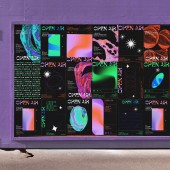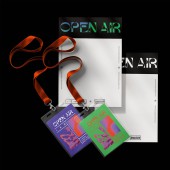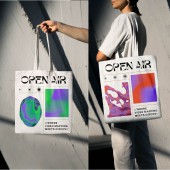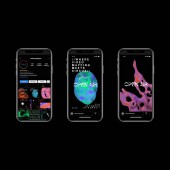
| THE AWARD |
| CATEGORIES |
| REGISTRATION |
| SUBMIT YOUR WORK |
| ENTRY INSTRUCTIONS |
| TERMS & CONDITIONS |
| PUBLICATIONS |
| DATES & FEES |
| METHODOLOGY |
| CONTACT |
| WINNERS |
| PRESS ROOM |
| GET INVOLVED |
| DESIGN PRIZE |
| DESIGN STORE |
| THE AWARD | JURY | CATEGORIES | REGISTRATION | PRESS | WINNERS | PUBLICATIONS | ENTRY INSTRUCTIONS |
Open Air Corporate Identity by AnaFatia |
Home > Winners > Design #131473 >Interview |
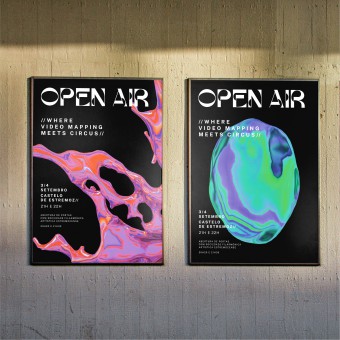 |
|
FS: What is the main principle, idea and inspiration behind your design?
AF: With the world closing down, we needed to find solutions that go against the absence of creation and sharing with others. It is in the context of this reflection we decided that since we were all left in a standstill and fluctuating in time the best would be to go for an experience where everyone would be (even if metaphorically) suspense in the air, in time, in fantasy and floating in the air. We found ourselves to redesign hope through action. The concept explores the unifying plasticity of togetherness and freedom between the organic movements of several individuals in regards to an abstract and surreal surface, almost invisible to our nave eyes like to serve atoms or micro-particles, observed under the light of a microscope. A dialogue between an abstract and a physical state. Open Air is the graphical identity & visual expression of the video mapping with vertical acrobatic dance show. The identity & visual graphical expression awaken connections and sensations felt immediately through abstract shapes that are also dynamic, organic, disruptive, nomad and adaptable. A language of fragments that are dissonant, heterogenous, transversal, surrealist, unstoppable; lines and compositions that transform themselves into an immersive illusion between 2D and 3D drawings.
FS: What has been your main focus in designing this work? Especially what did you want to achieve?
AF: we wanted the symbiosis of an artistic, expressive, in motion affirmative voice, without artifice, that breaks with any classical or modern channel assuming all of us. The biggest challenge was the 3D elements in combination with the technical specifications of video mapping, together with the robotic part (performance of vertical dancing).They are two areas with characteristics full of specific and challenging technological components, in their three-dimensional operation, between space and time, especially when working with different components at a formal level, such as, textures, shadows, and reflexes. The combination of all these elements really needs to be precise for our achievement, the combination of a visual expression can represent the interaction between video mapping with vertical acrobatic dance shows.
FS: What are your future plans for this award winning design?
AF: Promote as much as we can, international and national and help to sell the show around the world, because our identity is stronger than ever.
FS: How long did it take you to design this particular concept?
AF: To be honest, I have been working as an Creative & Art Direct in the world of video mapping shows for over 6 years. The intensity of projects is absolutely incredible and unexpected, the way before the “covid” our expansion was absolutely growing at a speed of 200%, and you need to be very fast, in all phases of the design process. This speed allowed us to gain immense experience in methodology and process organisation, which always led us to a design process of co-creation and co-production. So we created a "black box" within the team, where we awaited the ideas that emerged in the act of speeding up the implementation of the shows, so that one day we could create a project from scratch and co-authored. The concept we worked on for more than 1 year. The idea, draft, experience, experimentation, maquetization, testing, 6 months. The implementation is 1 month. In reality, in all this process, the strategy of the brand we do at the same time of creation and execution and the corporate identity we do at the same time of implementation and the timetable was 2 weeks. For us to do that, the process needs to be very pragmatic and very focos.
FS: Why did you design this particular concept? Was this design commissioned or did you decide to pursuit an inspiration?
AF: This particular concept was designed because we approach art in different forms and we cooperate because we believe in hope. That hope we are interested in is about broad perspectives with specific possibilities, ones that invite or demand that we act. It is not a just transition, it is a just transition that is urgently needed. A transition that is based on our ethical awareness and understanding of the interaction between movement humans. The transformation of the urban and a magistral state by sharing among themselves what inspires us, what represents us, and what we oppose. A movement of freedom in the time of pandemic world, because when we start all of this, we are in lock down. So we break the rules to give something to the community when they come back, we give hope and freedom. This project was an invitation by oskar & Gaspar, one of the largest companies in the world and pioneers in entertainment shows in the area of video mapping, (body and face), with numerous recognized awards. Oskar& Gaspar is a client I have had for more than 6 years. Together we develop more than 100 projects around the world. Our partnership is based on a relationship of trust and freedom. It is with great satisfaction and pride that I have a long-term "marriage" with the collective Oskar & Gaspar. We are a creative family and so it was and will always be possible to do projects of this dimension in a pandemic time. But the summary is simple, we are a very important example, in an exponential work economy, between two Portuguese brands that have a common objective, to internationalise themselves in the outside world.
FS: Is your design being produced or used by another company, or do you plan to sell or lease the production rights or do you intent to produce your work yourself?
AF: Our work is already represented to the public in September at Estremoz and once is a project for a cliente. Our expectation is that our client can sell a lot of shows for us to replicate in different places around the world. In that way, we can see more people interacting with your work.
FS: What made you design this particular type of work?
AF: One of the strongest points of a creative character, it is important to adapt to all the processes that creativity requires and is without being different for each project or multidisciplinary interpretation challenge to achieve visual and diversified consumption in various concepts to create, never forgetting the expressiveness to be produced in a language. After all, creating is a language and the whole process is another language. As I always say: “it doesn't matter how, or when, there is no right or wrong, there is your experience and its uniqueness, because the certainty of non- uncertainty is not all of us, from the first moment of creation".
FS: Where there any other designs and/or designers that helped the influence the design of your work?
AF: In general, my biggest source of inspiration is always experimentation along with trial and error. Looking around with eyes of “seeing” what we call the look of creative visual vibration. The visual search for constant elements and actually traveling, being in contact with people from many different cultures and communities. Live intensely different experiences, listen, feel, live, experience, everything that surrounds us daily, because everything is a source of inspiration, the way they are made, the way you interact with them, the way you communicate, the way how we live, the way we interact, everything is a source of inspiration, or I wouldn't believe that - FROM THINGS ARE BORN THINGS. My biggest research sources always come from the different part of visual arts, design, architecture, in artists, such as Salvador Dalí, Henri Matisse, Antoni Gaudí, Goya, Bruno Munari, Achille Castiglioni, Ross Lovegrove, Santiago Calatrava, Caravaggio and Zaha hadid. In particular this project, we do research of inspiration in the artist Escher and Memphis Group.
FS: Who is the target customer for his design?
AF: The Main customer it's the community of each city, of each country where the show can be presented and in this case the interaction of our design between the audience is empathy, mystery, and information. The audience can feel a connection among colours and movements extracted to create mysteries and empathy. We will not reveal much but enough so they can be present throughout the moment. Moments before the show, waiting for the performance they can recognise all the elements of the brand they have already seen before. Therefore, this show gives the audience a total dynamic sense, not only because people have to be present at the performance, but because the show will reveal its own secrets while happening, making them absorb all the information.
FS: What sets this design apart from other similar or resembling concepts?
AF: The biggest challenge was the 3D elements in combination with the technical specifications of video mapping, together with the robotic part (performance of vertical dancing).They are two areas with characteristics full of specific and challenging technological components, in their three-dimensional operation, between space and time, especially when working with different components at a formal level, such as, textures, shadows, and reflexes. The combination of all these elements really need to be precise.
FS: How did you come up with the name for this design? What does it mean?
AF: The significance of the name came from the need for everyone to need "air" in its true sense, due to being closed for so long during the pandemic. This is a project created in Portugal during the time when no one was allowed to leave the house. We broke the rules, isolated ourselves and created an artistic residency within what were the rules of the pandemic in Portugal. That's why the name literally arises from the need for artists to need to catch "air", so we don't die but breathe as best as possible during the pandemic period.
FS: Which design tools did you use when you were working on this project?
AF: The tools used were several and very different from each other through each phase of the project, since this is a very large project and involves several teams to be carried out in its entirety. In the first phase, the analysis of the briefing with the client is one of the most important for the success of the project and any creation. As a creative and artistic director, in a 1st phase, I carry out with the client a methodology of “Design thinking” with several exercises such as:(1)Workshop on “Yourself, Your Business and Your Brand”, between the present, past and future. The client will have to answer this questionnaire alone through his free thought.(2)workshop with the entire team involved in the project, we make a “Creative Model Canvas”. We define all the parameters of the business value proposition in two parts, Value and Effectiveness.(3) workshop with the whole team, we do a “Brand Attributes'. We approach the definition of Culture, Customer, Voice,Felling,Impact and X-Factor of what the customer wants for the representation of their brand. All these exercises are absolutely fundamental for the success of the creation and conceptualisation of each project. After that, the design methodology for creative development begins. Creativity, Execution, Implementation. Always need to be half Idealistic and half pragmatic in creation and development of artistic concepts more project planning, research and sketches. Execution - Project development, experimentation and materialisation of the artistic concepts both in 2D and 3D, with specialised tools, from Illustrator, Photoshop, Cinema 4D, 3D Studio Max, as well as specialised video and projection equipment to carry out all the necessary experiments to realize that everything works on combining various 2D, 3D, and projection elements. Experimentation - All the tests necessary to be able to model the final project. Implementation - Final presentation of the project with all the necessary means to make it shine as if it were the official presentation.
FS: What is the most unique aspect of your design?
AF: The identity and visual graphical expression awaken instantaneous connections and sensations felt immediately through abstract shapes that are also dynamic, organic, disruptive, nomad, adaptable. A language of fragments that are dissonant, heterogenous, transversal, surrealist, unstoppable; lines and compositions that transform themselves into an immersive illusion between invisible to visible ones using 2D and 3D drawings, typography, colours, textures, and compositions, inside a realm in a spectrum of semi-optic between art and technique for a better communicative interpretation. Openness, impurity, and intensity. The typography selection is an aesthetic, formal, functional, futuristic, and idealistic interpretation of a three-dimensional envision of the possibilities of the logo to be created. The typeface has the presence of movement we need to develop the symbiotic between the identity of the overall concept to communicate. We concluded that it could not be static and straight, but it had to be a combination between straight and round, sans serif and for exhibition. Organic, elastic, and with transformation potential, versatility, and dynamism to reach all senses of age and culturally diverse audience. The grotesque as a preeminent DNA in the construction of elements as glyphs, gradients, 3D shapes, textures, compositions, and animations always respect the assumption relative to the artistic concept of movement, union, liberty, and plurality.The gradients are one of the main elements of visual graphic expression that responds to the artistic concept of movement and togetherness. Through the colours and identity, the formal dynamic can provide feelings of plastic, elasticity, and organicity. Glyphs are another complementary element of the graphic identity respecting the artistic concept of movement, togetherness, freedom, and plurality. They are versatile and mutable and easily applied, and they also bring a graphic expression’s uniqueness. One of the most demanding biggest challenges was the 3D elements in combination with the technical specifications of video mapping, together with the robotic part (performance of vertical dancing). They are two areas with characteristics full of specific and challenging technological components, in their three-dimensional operation, between space and time, especially when working with different components at a formal level, such as textures, shadows, and reflexes. The result is the symbiosis of an artistic, expressive, in motion affirmative voice, without artifice, that breaks with any classical or modern channel assuming all of us. Creating three-dimensional shapes resulted in perfect symbiosis with the show. Translating visually various microscopic materials.
FS: Who did you collaborate with for this design? Did you work with people with technical / specialized skills?
AF: Yes, in this type of project, where the identity is a part of another part, it is really important to be presented when the Creative & Art Direction of the show is made, because it’s very organic and can change in a minute. The team needs to be very collaborative and participative. In this particular case, I have the opportunity to do the Creative & Art Direction to the Graphics, Illustration and Visual Communication and at the same time the Creative & Art Direction of the concept show. I work as a lead designer for two teams, because of that it was faster and efficient to create and find a solution for the cooperative identity. Our team is very big and diversity with a lot of people very specialist in differents areas, as creation, interpretation, conception, production, idea, co-creation, project director, production management, director assistant, content management, 3D content management, creative & art direction, artistic assistance, 3D design creation contents, original soundtrack, associate producers, strategic partners of lights and robotic, communication advisor, graphic & motion design, photographic record and making of creation, filmmaking, capture, editing, video editing, operation video. We always work together in a collaborative process.
FS: What is the role of technology in this particular design?
AF: Starting from this surreal base and simultaneously having as an ally the fusion of physical movement as a phenomenon, through this ability to represent the being in collective and flexible movement: we find an extremely microscopic world of atoms, ions, electrically charged atoms, under energy forces. These are the same energy forces that generate attraction and repulsion and guide all forms of giving life to various elements such as human relationships. The ability to unify through a collective representation in extraction, attraction and repulsion on the movement of human bodies in a symbiosis of 2d or 3d, abstract, surrealist and colourful figurative drawings. We interpret the development of a gear of precise and robotic movements in the creation of patterns that can be dissolved in countless combinations, as a result we arrive at a physical, technological, innovative vision, in a liquid landscape, and a dazzling beauty of motion and digital experience.
FS: Is your design influenced by data or analytical research in any way? What kind of research did you conduct for making this design?
AF: Yup. Since we are talking about a brand for a video mapping show with acrobatic dance at the same time, in this aspect the biggest research reference was the dance show with projection called: "Pixel" - it is, for me, one of the most magnificent works, and of greatest movement references with “dada” in the field of theater performances. In video mapping, and in our case in particular, body projection, its interaction and simulation is fundamental, but the most incredible thing is that, unlike the "data'', which is precise and analytical, we use it as research to do the opposite. , our precision lies in simulating the interaction as if it were magic. It's a technique we call "new circus".
FS: What are some of the challenges you faced during the design/realization of your concept?
AF: One of the most demanding the biggest challenge was the 3D elements in combination with the technical specifications of video mapping, together with the robotic part (performance of vertical dancing).They are two areas with characteristics full of specific and challenging technological components, in their three-dimensional operation, between space and time, especially when working with different components at a formal level, such as, textures, shadows, and reflexes. The combination of all these elements really need to be precise. Creating three-dimensional shapes resulted in perfect symbiosis with the show. Translating visually various microscopic materials.
FS: How did you decide to submit your design to an international design competition?
AF: After we presented to the public because I realised the challenge of the final result was achieved. we wanted the symbiosis of an artistic, expressive, in motion affirmative voice, without artifice, that breaks with any classical or modern channel assuming all of us and we really do that.
FS: What did you learn or how did you improve yourself during the designing of this work?
AF: Everything is possible. No limit for creation and cooperation.
FS: Thank you for providing us with this opportunity to interview you.
A' Design Award and Competitions grants rights to press members and bloggers to use parts of this interview. This interview is provided as it is; DesignPRWire and A' Design Award and Competitions cannot be held responsible for the answers given by participating designers.
| SOCIAL |
| + Add to Likes / Favorites | Send to My Email | Comment | View Press-Release | Translations |
